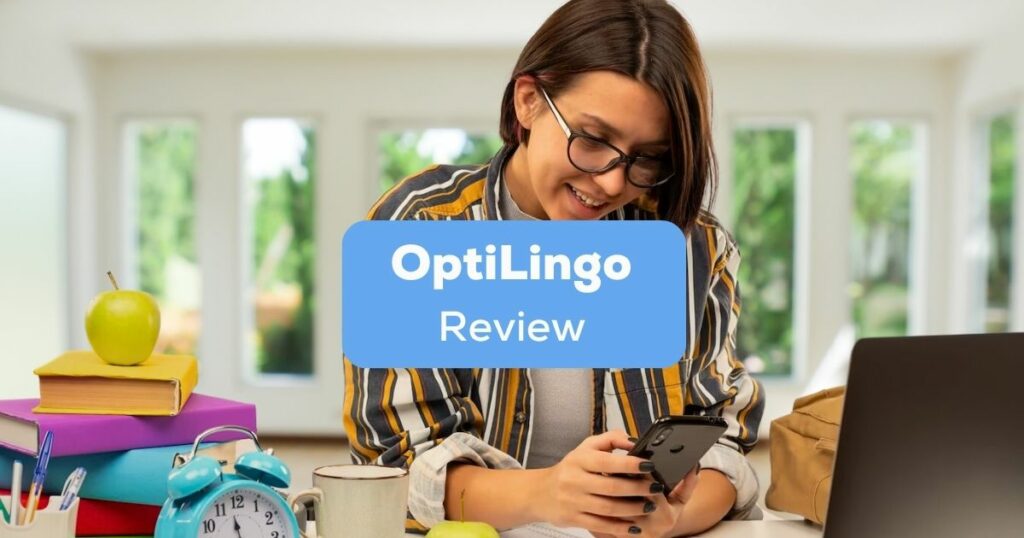Did you know it takes 270 hours for a college student to reach fluency in a language? OptiLingo says you can do it in a third of that time. Yep, just 20 minutes a day. Now that’s something to think about, right?
In this OptiLingo review, we’ll dive deep into every aspect of the app, from its unique “Guided Immersion” method to the languages it offers and everything in between.
So, why is this important? Because we all want to learn a language fast and effectively. If OptiLingo can truly deliver on its promise, you could chat in a new language without the usual time sink. Stick around; we’ll explore all the specifics you need to know.
What Is OptiLingo?
Let’s get straight to it. OptiLingo is a language-learning app, but it’s not just any app. It uses a unique approach called “Guided Immersion.” This method is all about listening and speaking, aiming to get you fluent with just 20 minutes a day.
The man behind this app is Jonty Yamisha. He’s not just a founder; he’s an accidental polyglot and an activist for endangered languages.
Jonty created OptiLingo after trying to learn his grandparents’ dying language, Circassian. His journey led him to develop this app, which launched with the goal of making language learning more efficient.
What Is OptiLingo For
You’re probably wondering, “What’s this app really for?” Well, OptiLingo is for those who want to get fluent without the long hours.
It’s designed to give you a working vocabulary that covers about 80-90% of everyday language. That means you’ll be able to hold a conversation in a new language without stumbling too much.
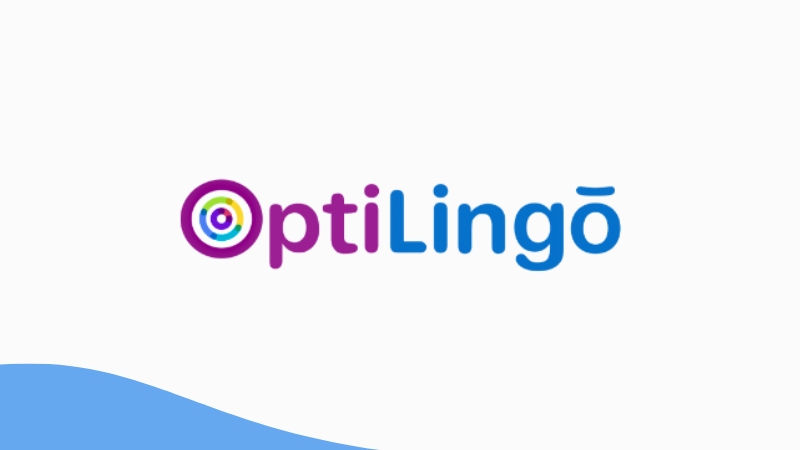
Languages Offered
OptiLingo offers 20 languages. You’ve got your usual suspects like English and Spanish, but it also offers less common languages like Circassian. Here’s a detailed look:
| Spanish | German | French | Russian |
| Chinese | Arabic | Circassian | Danish |
| Dutch | Hindi | Icelandic | Italian |
| Japanese | Korean | Norwegian | Polish |
| Portuguese | Romanian | Swedish | Turkish |
Learner’s Level
Now, who can actually use this app? OptiLingo is perfect for beginners and those at an intermediate level.
If you’re new to language learning or have some basics down but want to get better at speaking and listening, this app is worth considering.
Who Is It For?
So, is this app for you? If you’re the type who learns best by listening and speaking, absolutely. It’s also a lifesaver for busy folks. The app’s designed for 20-minute daily sessions, making it super easy to fit into a hectic life.
| Pros | Cons |
| Clear audio, thanks to native speakers. | Limited focus on reading and writing. |
| The design’s so simple anyone can use it. | Lessons lack contextual explanations. |
| At $9.99/month, you’re getting a good deal. | Fixed structure of 100 lessons per language. |
| Choose from 20 languages, even the rare ones. | Not suitable for advanced learners. |
How Does OptiLingo Work?
OptiLingo is not just another app you download and forget. Think of it as your language guide, focusing on real-world words and phrases. And yes, you only need 20 minutes a day to make it work for you.
Getting Started With OptiLingo
- Visit the Website or App Store: Head to OptiLingo’s website or find the OptiLingo app on Google Play or the App Store.
- Choose Your Language: During the signup process, you’ll pick the language you want to learn. Make it count!
- Create an Account: You can use your email and create a password, or simply use your existing Google account to make things easier.
- Confirm Your Email: You’ll get a confirmation email. Click the link inside to activate your account.
- Start Learning: Once you’re in, just hit the play button, and you’ll kickstart your first lesson.
Guided Immersion
Now, let’s talk about “Guided Immersion.” This isn’t some fancy term they threw in. It’s their way of saying, “Hey, we’ll teach you the stuff that people really say, not just textbook talk.”
This is their core teaching method, and it’s all about real-world language. What does that mean for you? You’re not just learning phrases that you’d find in a textbook. Instead, you’re getting the language as it’s actually spoken in everyday life.
You’ll learn the words and phrases you’d hear in a cafe, at a friend’s house, or while shopping—basically, the language you’ll use in real conversations.
Listen, Repeat, Speak
With OptiLingo, you listen to a phrase in English, then the same phrase in your target language from a native speaker.
Your job is to echo it back. It’s like having a conversation but with training wheels on so you get the hang of pronunciation.
Lesson Structure
You’ve got 100 passive audio lessons for each language. Each one is a neat 20-minute package. Stick to it five days a week, and in a year, you’ll be chatting away.
Spaced Repetition
OptiLingo’s got this thing called a Spaced Repetition System (SRS). It’s their way of ensuring you don’t forget what you’ve learned.
You’ll revisit old stuff every now and then. Just a heads-up, though, it’s the same old, same old—so it can feel a bit like deja vu.
Audio Speed Control
Ever listen to someone and wish they had a speed dial? Well, OptiLingo does. You can slow down or speed up the audio.
It’s super handy for languages where you’re like, “Wait, what did they just say?”
No Drills Or Memorization
If the thought of rote learning makes you yawn, you’re in for a treat. OptiLingo is all about learning in a way that feels natural.
You’re not just memorizing words here. You’re learning phrases in the context of real conversations.
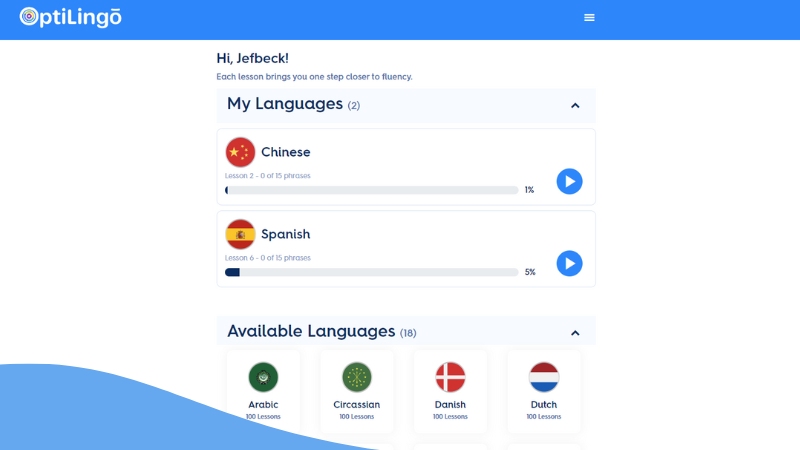
How Is The Design And Interface Of OptiLingo?
Alright, let’s get down to the details of OptiLingo’s design and interface. The app is all about simplicity, focusing on an audio player and a stats section. So, what’s in it for you?
Basic But Functional
You open the app, and boom, there’s the audio player with play, pause, and skip buttons. These buttons are big and easy to spot, so you won’t waste time figuring things out.
On the web, it’s just as straightforward. You’ve got three main sections: ‘Learn Languages,’ ‘Practice Languages,’ and ‘Profile.’ Each has a clear purpose, making sure you know exactly where to go.
User-Friendly
So, you’re in the app, and a list of lessons greets you. Each lesson has a label and a progress bar, so you know what you’ve done and what’s next.
The web version is just as user-friendly. You can sort languages by category, difficulty, or how popular they are.
Visual Appeal
The app keeps it clean with whites and blues. No flashy stuff here, just a focus on learning.
The web version also sets a positive vibe with bright, inviting colors. Both platforms use fonts that are a breeze to read and spacing that makes everything easy to navigate.
Navigation
In the app, a menu icon in the top corner is your gateway to settings, stats, and help. The stats are a gem. They show you the number of words you’ve learned and the lessons you’ve completed.
The web version is no slouch, either. Menus are clear, buttons are where you’d expect, and it’s all designed to get you learning, not lost.
What Are The Features Of OptiLingo?
Is OptiLingo really different from all the other top language apps you’ve tried? Let’s delve into its unique features to find out what sets it apart.
Slideshow Of Phrases
First off, OptiLingo works like a digital phrasebook but in a slideshow style. You get 100 lessons for each of the 20 languages it offers.
In each lesson, you see phrases in both English and the language you’re learning. But here’s the thing: there’s no guide on what topic you’re learning or what you should aim to know by the end of the lesson.
Lots Of Practice Material
You get a lot of phrases to practice with—29 hours worth, to be exact. That’s a lot of time you can spend learning.
But remember that the app doesn’t promise to make you fluent. It’s more like a practice tool than an entire course.
More Than Just Flashcards
If you’re bored with flashcards, this app changes things up. Instead of cards, you get a slideshow of phrases.
It’s a different way to learn a language, but there’s a downside. The phrases aren’t sorted or graded, so you must keep track of your progress.
Make It Your Own
Here’s a nice touch. You can change some settings to fit your needs. Want to make it harder? You can turn off the English translations. You can also change how fast the voice speaks so you can learn at your own pace.
No Clear Goals
Now, for the not-so-great part. The lessons don’t have specific topics or goals. You’re basically learning phrases without knowing how they fit into the bigger picture. If you like having a clear plan, this could be a problem for you.
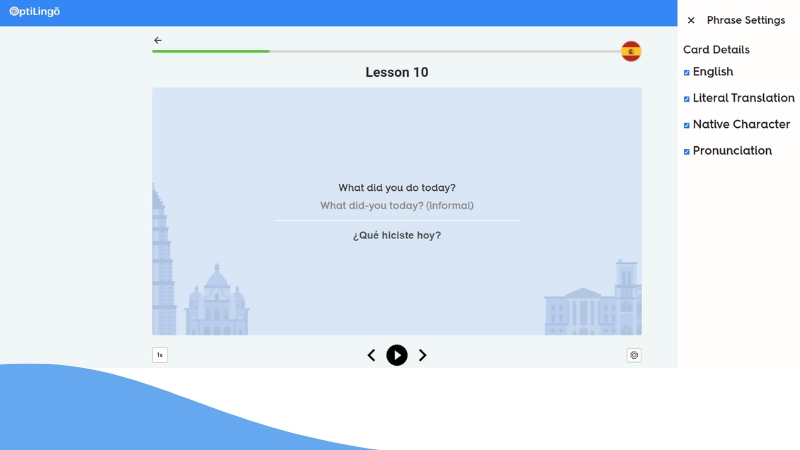
Who Is OptiLingo For?
You’ve got a good grasp of what this app offers in this OptiLingo review. Now, let’s pinpoint who exactly stands to gain the most from this platform and why.
- Busy Professionals: You’re juggling meetings and deadlines. OptiLingo only asks for 20 minutes a day. That’s a lunch break or a commute. And the payoff? You’re conversing in a new language without messing up your schedule.
- Travel Buffs: You’re the type who wants to go beyond tourist spots. OptiLingo gets you to order food or hail cabs in the local language.
- Rare Language Fans: You’re into multiple languages that most people haven’t even heard of. OptiLingo offers those. It’s not just Spanish or French; we’re talking Circassian and Icelandic.
- Listen and Learn Types: You remember lyrics more than textbook lines. OptiLingo is all about listening and repeating. It’s like your favorite song, but it’s a language lesson.
- Newbies: You don’t know where to start? OptiLingo kicks off with phrases you’ll actually use. No Shakespearean English or scientific jargon. Just, “Hi, how are you?”
- Tech-Shy Folks: You don’t need a manual to use OptiLingo. It’s as simple as pressing play. Perfect for those who don’t want to wrestle with settings and menus.
- Language Dabblers: You love switching it up. One day, it’s Italian; the next, it’s Japanese. OptiLingo has 20 languages. You won’t get bored.
- Parents with Kids: You want your kid to say more than just “Hola.” OptiLingo’s audio clips are short and catchy.
- Podcast Junkies: You’re already plugged in for your daily podcast dose. Why not add a language lesson to the mix? OptiLingo fits right into your listening routine.
- Community Connectors: You’re the bridge in your community. Maybe you’re a social worker or a local leader. OptiLingo helps you break language barriers, making your work more impactful.
How Much Does OptiLingo Cost?
Let’s cut to the chase. You want to know how much OptiLingo will set you back. So, here’s the latest scoop on their pricing.
Free Trial
OptiLingo offers a 7-day free trial that gives you access to all 20 languages on the platform. This is a limited trial, though.
You can explore 10 lessons, use the features, and get a feel for how it works. If you like what you see and want to keep going, several subscription options await you after the trial ends.
Subscription Plans
After your free trial, you’ve got choices. OptiLingo offers three subscription plans, each with its own set of perks. Let’s break it down:
| Plan | Cost Per Month | Total Cost | Billing Cycle |
| Monthly | $9.99 | N/A | Charged Monthly |
| 3 Months | $7.99 | $23.97 | Charged Every 3 Months |
| Annual | $5.99 | $71.88 | Charged Annually |
What’s Included In All Plans
- Complete Access: You can dive into 100 lessons in each of the 20 languages. No limits.
- High-Frequency Phrases: You’ll focus on the words and phrases people actually use, not textbook filler.
- Hands-Free Learning: You’re not tied to one device. Switch from your phone to your tablet to your computer, no problem.
- Sync Progress: Wherever you left off, that’s where you’ll start. Your progress syncs in real-time across all devices.
- Spaced Repetition: No cramming here. The app brings old lessons back for review, so it sticks.
- Short Sessions: Got 20 minutes? That’s a lesson. It fits into your life, not the other way around.
Extra Perks
- Lifetime Money-Back Guarantee: Yep, you read that right. If you’re not happy, you get your money back. No questions.
- SSL Security: Your payment info is locked down. No worries about security here.
- Language Preservation: A slice of your payment helps save endangered languages. You’re not just learning; you’re helping preserve culture.
Which Option Is Best?
Alright, let’s get real. You’re probably wondering which subscription plan gives you the most value for your money.
Based on the details, the Annual plan stands out as the most cost-effective. At $5.99 per month, billed as $71.88 annually, you’re saving quite a bit compared to the Monthly and 3-month plans.
Now, why would I recommend this? Learning a language isn’t something you can master overnight. It takes time and consistent effort.
Committing for a year gives you the runway you need to make real progress. Also, the annual plan’s cost per month is the lowest, so you’re getting the same features as the other plans but at a reduced rate.
And don’t overlook the perks. All plans come with a Lifetime Money-Back Guarantee. So, even if you go for the Annual plan and decide OptiLingo isn’t for you, you’re not stuck. You can get your money back. Simple as that.
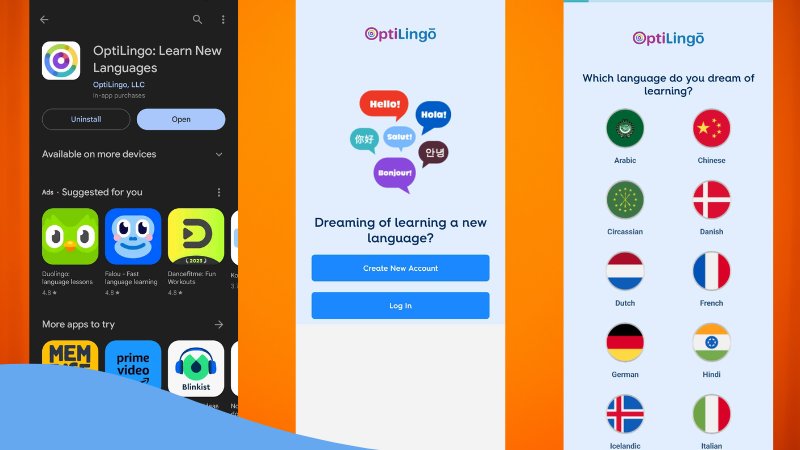
How I Used OptiLingo To Review It
I’ve spent three weeks with OptiLingo, and I’m here to tell you my experience, from the first tap on “Install” to diving into lessons and even requesting a refund.
The Download And Setup
I found OptiLingo on Google Play, hit “Install,” and I was in within a couple of minutes. The setup was smooth—no hiccups.
I chose Spanish as my language. Why Spanish? Well, I’m Filipino, and our language has a ton of loanwords from Spanish. I was curious to see how much overlap there’d be.
The Initial Attraction
I first bumped into OptiLingo when I was hunting for language apps with podcasts for a roundup article.
It didn’t make the cut because apps like Beelinguapp were more podcast-centric. But OptiLingo stayed on my radar.
Kicking Off With The Free Trial
I started with the 7-day free trial. On day one, I jumped into a lesson on basic greetings. “Hola” (Hello), “¿Cómo estás?” (How are you?)—the basics.
The audio was clear, and the phrases were practical. There’s no fluff, just stuff I’d actually use.
Taking The One-Month Plunge
Post-trial, I opted for the one-month plan. Cost me $9.99. I continued with Spanish, and here’s where it got cool.
I learned a few phrases like “¿Cuánto cuesta?” for asking prices, “Estoy perdido” when you’re lost, and more. Super useful in everyday life.
Syncing And Switching Devices
One thing I loved was the real-time syncing. I started lessons on my phone and picked up right where I left off. It was seamless, and I never felt like I was losing progress.
The Highlights
The 20-minute sessions were a godsend. And the spaced repetition? It brought back older lessons like “¿Cómo estás?” just when I was about to forget them. No cramming, just natural learning.
Testing The Money-Back Guarantee
Two weeks in, I decided it was time to test their refund policy. Now, don’t get me wrong, I didn’t quit because the app wasn’t good. I actually bought the one-month subscription primarily to give you all a comprehensive OptiLingo review.
So, I reached out to customer service, requested a refund, and guess what? The money was back in my account within 48 hours. No questions asked. Just like they promised.
What I Like
- Clear Audio: Based on my experience, the native speakers in the audio really elevate the learning. I never had to second-guess what was being said, which made my lessons more effective.
- Simple Design: The user interface is a breeze. When I first opened the app, I immediately found everything I needed. No fuss, no confusion, just straight to learning.
- Language Variety: This was a standout for me. The app offers 20 languages, including some that are hard to find on other platforms. As someone who’s curious about less common languages, this was a big plus.
Areas For Improvement
- Limited Reading and Writing: While using the app, I noticed it leans heavily on improving listening and speaking skills. I missed having more reading and writing exercises to round out my language skills.
- Lack of Context: The lessons give you the phrases but don’t tell you much about when or why to use them. I found myself wanting more background info to fully understand the language.
- Fixed Lesson Structure: The 100 lessons per language are good but limiting. After a while, I felt like I needed more variety or additional lessons to keep advancing.
- Not for Advanced Learners: As I progressed, it became clear that the app is geared more towards beginners and intermediate learners. I could see advanced users wanting more language acquisition, depth, and complexity.
Wrapping Up OptiLingo Review
Three weeks with OptiLingo gave me a lot to chew on. The audio? Crystal clear. The design? It was so user-friendly my grandma could navigate it. But the app could use a boost in the reading and writing department.
The features? Solid. Real-time syncing and short lessons fit right into my life. And get this: part of your payment helps save endangered languages. That’s a unique perk you won’t find just anywhere.
So, would I recommend OptiLingo? For beginners and intermediate learners, it’s a yes from me. It’s got a lot of perks, and the price is reasonable. But if you’re already fluent in five languages and looking for your sixth, maybe not.
In the end, OptiLingo does many things right, but it’s not the be-all and end-all. It’s a strong option, especially if you care about language preservation.
But hey, the choice is yours. Take what you’ve learned in this OptiLingo review and see where it leads you. Your move.
Learn Not 20, But 60+ Languages With Ling!
Hold on, before you click that “subscribe” button on OptiLingo, let’s talk about the Ling app. This app lets you learn over 60 languages. Yeah, 60! It’s like the Netflix of language apps.
Now, what makes the Ling app special? It’s not just a flashcard app. It’s like a mini-language school on your phone.
You get to play games, take quizzes, and even practice writing. It’s a 360-degree approach to language learning. And it’s not just for beginners; it caters to all levels.
And you know what? Our website pumps out daily articles on all things language. Grammar, culture, you name it. So you’re not just learning; you’re becoming a mini-expert.
You can download the Ling app on Google Play and the App Store. So, no matter what phone you’re using, you’re set.
If you want a complete language learning experience, the Ling app is the better choice. It offers more than OptiLingo and makes learning fun and deep. Trust me, once you try the Ling app, you won’t look back.
